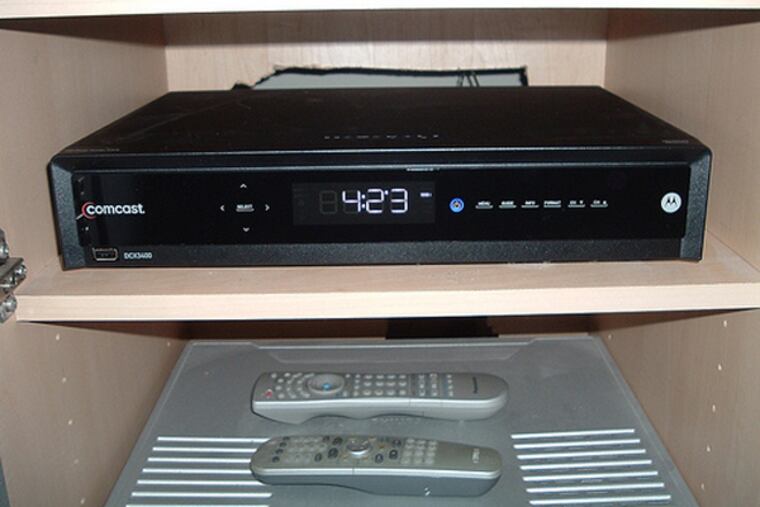Agreement sets standards for set-top boxes
The pay-TV industry, threatened with federal regulations, has plunged a stake into the electric "vampire" in your living room. After a year of negotiating, Comcast Corp., DirecTV and other TV operators agreed last week to energy-efficiency standards for set-top boxes, which can suck more electricity off the grid than wide-screen TVs.

The pay-TV industry, threatened with federal regulations, has plunged a stake into the electric "vampire" in your living room.
After a year of negotiating, Comcast Corp., DirecTV and other TV operators agreed last week to energy-efficiency standards for set-top boxes, which can suck more electricity off the grid than wide-screen TVs.
The reason: Set-top boxes don't turn off - even when a subscriber turns off the TV, or the boxes themselves. Critics have called them electric vampires.
TV distributors "didn't pay the electric bill so they had them on all the time," Noah Horowitz, a senior scientist with the Natural Resources Defense Council, who coordinated a 2010 study exposing set-top box electric usage, said last week.
Consumers spend $30 to $50 a year for electricity for set-top boxes and DVRs, which shouldn't break the family budget. But the pay-TV industry is huge, and set-top boxes put a burden on the nation's electric capacity. Set-top electric usage also soared because of more sophisticated boxes that record TV shows, and offer high-definition TV. One estimate pegs the number of set-top boxes in American homes at 160 million.
The set-top box - a black rectangular device with a clock and channel-changing capability - connects the household TV to the cable- and satellite-TV system so a subscriber can view hundreds of channels of entertainment, sports, and news.
The voluntary commitments are projected to save about $1 billion in costs of electricity annually by 2017.
The total energy savings could power 700,000 homes and avoid five million metric tons of carbon dioxide emissions a year, according to the U.S. Department of Energy.
The federal agency considered new energy-efficiency regulations on set-top boxes but has abandoned those plans with the industry's agreed-to efficiency standards, reported trade publication Communications Daily, one day after the announcement of the agreements.
Increasing savings
As part of the agreement's first phase, the pay-TV industry will participate in the Environmental Protection Agency's Energy Star program. Ninety percent of the set-top boxes purchased in 2013 by big pay-TV operators will carry an Energy Star Version 3 rating - which means they were certified by an independent lab.
A set-top box with an Energy Star 3 rating is 45 percent more efficient than conventional set-top boxes, said Brian Dietz, spokesman for the National Cable and Telecommunications Association. Consumers benefit as the pay-TV operators swap out old set-top boxes for new ones, he said.
"Set-top boxes evolved from a simple device to a small computer that required a lot of electronics and a lot of energy," Dietz said Friday.
A second phase of the agreement will lead to more efficiencies as the pay-TV operators and equipment manufacturers develop new configurations or modes for the set-top boxes.
The National Cable and Telecommunications Association negotiated the commitments with the Natural Resources Defense Council, the Appliance Standards Awareness Project and the American Council for an Energy Efficient Economy.
The cable companies that signed the agreement, in addition to Comcast and DirecTV, were Cablevision Systems Corp., Charter Communications Inc., Bright House Networks L.L.C, Cox Communications Inc., Time Warner Cable Inc., A&T Services Inc., Verizon Communications Inc., CenturyTel Broadband Services L.L.C. and Dish Network.
Equipment manufacturers Cisco Systems Inc., Motorola Mobility L.L.C., Arris Group Inc. and EchoStar Technologies also participated.
Part of a process
The Energy Department said the "non-regulatory agreement" was one of many for household or commercial products reached under the Obama administration that are estimated to save consumers $400 billion through 2030.
The focus on set-top boxes is part of a broader look at energy consumption by consumer electronics in the home.
R. Neal Elliott, associate director for the American Council for an Energy Efficient Economy, said advocates are looking to reduce the "plug loads" in a home - TVs, desktop computers, laptops, cell phones, cordless phones, routers and printers, in addition to set-top boxes. The devices individually aren't large electric users, but together they add up.
In 2010, Horowitz managed a study that showed that consumers spent about $3 billion on the electricity for set-top boxes and DVRs.
That 2010 report estimated that national household set-top box electricity consumption roughly equaled the total electricity consumption in the state of Maryland. Subscribers nationally spent $2 billion a year on electricity for set-boxes when they weren't watching TV, the report estimated.
Horowitz's conclusion was that the pay-TV industry "needed to buy better boxes and they had to make more information available on how much energy the boxes consumed. Right now it's virtually impossible to find this information."
He believes that the voluntary commitment is a good first step and that with more information available on set-top box electric efficiency, the equipment manufacturers will compete to design more efficient boxes.
"We know all consumers are not interested in this," Horowitz said, "but all consumers will benefit."